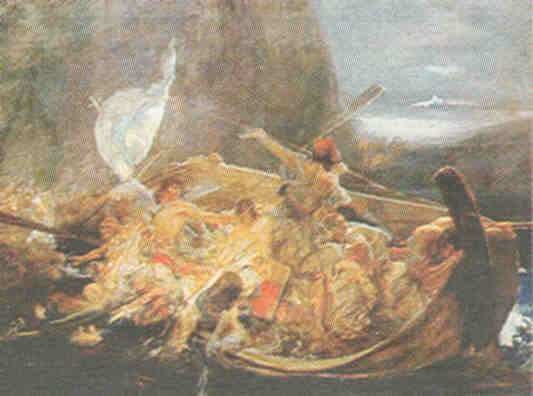 |
|
|
|
|
 22 June 1824 |
|
|
|
|
ON 22 JUNE 1824, Turkish and Egyptian forces that had sailed from the neighbouring island of Chios completed the conquest of Psara and the slaughter of its inhabitants during a very crucial period in the course of the Greek revolutionary war against the Ottoman Empire. On the morning of June 20, the Turkish fleet, comprising 176 ships (warships and transports), sailed from Sigri on Mytilene heading for Psara and carrying 17,000 Turkish and Albanian troops. |
 Nikolaos Gyzis' After the Destruction of Psara |
|
The islanders were aware of the impending invasion and had begun reinforcing the island's defences, especially around the southern and western beaches, as the shores around the north and east were steep and inaccessible. The parliament of Psara undertook its role as coordinator of the defences. Psara had a very democratically-minded tradition, and the inhabitants staged yearly elections in which all social classes participated elected 40 representatives, who in turn elected five unsalaried elders. The beaches were, indeed, organised with cannon emplacements and trenches. However, the defenders made one tragic mistake. In trying to placate the mercenaries, the locals agreed to remove the rudders from their significant fleet, so that it would be ingrained in all that resistance would be to the end. Thus, they rendered their ships useless. They also spread their forces throughout the island and kept the non-combatants on the island. The Turkish armada dropped anchor at the shallow bay of Kanalos on the island's northwest side on the afternoon of the same day it sailed. Despite strong naval bombardment, the Turks were unable to land their troops. The next day, despite an intensification of the bombardment, the Turks were still unable to gain a foothold. However, naval scouts found they could disembark at the place called Cavo Markaki. There they disembarked and proceeded to destroy the positions of the defenders piecemeal. Very quickly they subdued the defenders throughout the island and began the systematic roundup and slaughter of the inhabitants. The scenes that followed were unimaginable. The streets were strewn with the corpses of old men, women and children. Some tried to reach the ships and replace the rudders. Few managed as Hosref's fleet had surrounded the island. The only resistance remaining by the end of June 21 was the small fort of Palaiokastro on the hill called Mavri Rahi (Black Ridge) that dominates the island's capital. Around 500 fighters and civilians defended the fort against around 6,000 Turkish troops. When the Turks broke through the' defences, Antonios Vratsanos blew up the powder magazine killing the defenders and the assaulting Turks. The destruction of the island was tremendous. Of the 30,000 inhabitants, 18,000 were massacred or sold as slaves. The picture of the destruction was given in the moving epigrammatic poem by Dionysios Solomos: Of the 100 or so Psarian ships, only 16 managed to escape along with seven fireships under Konstantinos Kanaris. The survivors sought refuge in Monemvasia, and after the liberation of Greece settled in the area of the ancient city of Eretria on Evia. The destruction of Psara dealt a serious blow to the revolutionary effort as it destroyed a very vital portion of the Greek navy. |
|
|
(Posting date 2 July 2007) HCS encourages readers to view other articles and releases in our permanent, extensive archives at the URL http://www.helleniccomserve.com/contents.html. |
|
|
|
|
2000 © Hellenic Communication Service, L.L.C. All Rights Reserved.
http://www.HellenicComServe.com |
|
